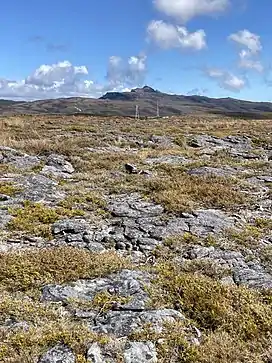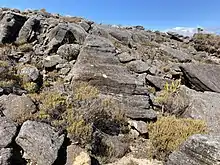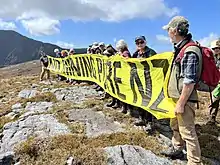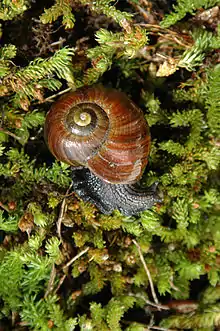Denniston Plateau
Denniston Plateau (technically the Denniston-Stockton Plateau) is an 18 km long, 600–800 m high coalfield plateau in the Papahaua Range on the West Coast of the South Island of New Zealand. A combination of impermeable rock, high rainfall, and shallow acidic soil has created a unique ecosystem of stunted trees and heath-like vegetation which is home to numerous endemic and undescribed species of plants and invertebrates. The plateau contains rich seams of high-quality coal, which led to the creation and abandonment of the mining towns of Denniston and Millerton, and the current Stockton Mine. Plans to create a new open-cast mine on the southern part of the plateau have become an environmental controversy.
| Denniston Plateau | |
|---|---|
| Denniston-Stockton Plateau, Mount Rochfort Plateau | |
 View south to Mt Rochfort | |
| Highest point | |
| Elevation | 600 m (2,000 ft) |
| Coordinates | 41°44′47″S 171°47′59″E |
| Naming | |
| Etymology | Named after the coal mine manager |
| Geography | |
| Location | Buller District, West Coast Region, New Zealand |
| Parent range | Papahaua Range |
Physiography
The Denniston-Stockton Plateau stretches approximately 18 kilometres (11 mi), from Mt Rochfort near Westport in the south to Granity in the north. It is about 3–4 kilometres (1.9–2.5 mi) wide, and 600–800 metres (2,000–2,600 ft) above sea level, lower at its northern (Millerton) and southern (Denniston) extents, and highest in the middle towards Mount Frederick.[1] It is bisected by the Waimangaroa River into Denniston and Stockton plateaus, which are sometimes referred to individually, though the term "Denniston Plateau" is often used to refer to the entire landform and ecosystem.
Geology
The main rock on the surface of the plateau is sandstone, which has eroded into coarse and acidic silica sand.[1] It is sometimes referred to as the "Buller Coal Plateau",[2] because beneath the sandstone are rich seams of high-quality bituminous coal, laid down in swamps 45 million years ago. Partly-decayed plant material was compressed into peat 42–45 million years ago, then covered over by encroaching ocean and rock, and compressed once again under the ocean into coal 37 million years ago.[1] The plateau was raised to its current altitude within the last 2 million years as part of the rapidly-rising Southern Alps.[1]

The soil on the plateau is thin at best, often infertile and low in organic matter, poorly drained, and acidic; miners in Denniston had to bring all the soil required to create their flower gardens and bowling green up the Denniston Incline.[3][4] The impermeable layer of sandstone means the ground is frequently waterlogged and there are large expanses of bare, eroded rock with no soil at all.[1]
Climate
The plateau has a harsh climate: high rainfall, low sunshine hours, cold, wind, and often mist.[3]
Flora
The vegetation of the plateau appears sparse and scrubby, but this is a consequence of the harsh climate and poor soils: there is a high diversity of plant species, and some of the bonsai-like small shrubs are hundreds of years old.[4] The plateau includes alpine plants found at unusually low altitudes and several localised or endemic plants.[1]

In more sheltered areas and better soils, the vegetation is a low forest consisting of mānuka (Leptospermum scopiarium), mountain five-finger (Neopanax colensoi), southern rātā (Metrosideros umbellata), and mountain flax (Phormium colensoi). In more exposed areas the growing conditions are similar to the pakihi swampland of lower altitudes, and contains similar species such as mānuka, tangle fern (Gleischenia dicarpa), and various rushes.[1] But the more varied topography of the plateau creates greater diversity of habitats and species, including bog pine (Halocarpus bidwillii), pygmy pine (Lepidothamnus laxifolius), yellow silver pine (L. intermedius), and several species of shrubby or stunted Dracophyllum.[1][3] North towards Millerton the rocky plateau has dwarfed kāmahi (Weinmannia racemosa), and both southern and northern rātā (Metrosideros robusta). Many small flowers occur on the plateau: gentians, eyebright (Euphrasia wettsteiniana), orchids such as the mauve sun orchid (Thelymitra decora) and swamp sun orchid (T. cyanea), and in wetter areas carnivorous sundews (Drosera spatulata).[1]
Some distinctive species include:
- Dracophyllum townsonii, restricted to the northern West Coast, and D. densum, found mostly on Denniston Plateau and the Paparoa Range nearby
- Four species of Celmisia daisies that reach their southern limit here or in the Paparoas: mountain daisy (C. dubia), scrub daisy (C. lateralis), Dall's mountain daisy (C. dalii), and C. similus.
- North Westland snow tussock (Chionochloa juncea), found only on the Denniston-Stockton Plateau
Fauna
The plateau has great spotted kiwi (Apteryx haastii), fernbirds (Poodytes punctatus) and New Zealand pipits (Anthus novaeseelandiae), as well as weka, kea, and riflemen. Reptiles include speckled skink, coastal green gecko, and forest gecko (which here inhabits scrubland).[3]
Several species of large carnivorous Powelliphanta snail are found on the plateau, and some are endemic to it and threatened by mining.[1]
- Powelliphanta patrickensis, found only on coalfields over 750 m between Denniston and Mt Rochfort and in the Millerton area
- Powelliphanta lignaria 'Millerton', found only on a few hectares near Millerton, thought to be extinct, and rediscovered in 2005
- Powelliphanta augusta, whose 5 ha of habitat on Mount Augustus was destroyed by the mining company Solid Energy. The entire known population was taken into captivity in refrigerated shipping containers in 2006. Attempted reintroductions in the Stockton area were unsuccessful, and most of the population remains captive, cared for by the Department of Conservation.[5]
In response to a proposed open-cast coal mine, 150 scientists and volunteers conducted a weekend "bio-blitz" on the plateau in March 2012 and discovered several new species:[6]
- a nationally critically endangered day-flying moth, Arctesthes avatar, described in 2019 and named after the movie Avatar, whose plot concerns a mining company destroying a pristine environment[7][8]
- a cave weta, informally dubbed the Denniston white-faced weta[9][10]
- a beetle, another moth, a wingless wasp, and three spiders[11]
Conservation


The northern part of the plateau has been heavily modified by Solid Energy's large Stockton mine. In 2011 Australian-based Bathurst Resources gained consents for the Escarpment Mine Project in the southern part of the plateau towards Mt Rochfort, which would involve stripping and "relocating" the surface vegetation, removing and stockpiling the sandstone layer, and creating an open-cast mine. The land would supposedly be rehabilitated after mining, but the unique drainage and soil conditions, and thus much of the biodiversity, would be destroyed.[2] This created years of conflict between an industry wanting jobs and profits for the people of the West Coast, and those who valued the unique and delicate ecosystem of the plateau.[1] Environmental groups fought the consents in court for two years but they were upheld by the Environment Court in 2013.[12] Forest and Bird proposed a 5900 ha reserve on the plateau, and organised a bioblitz to learn more about its species diversity.[2] Bathurst was given consent to mine the plateau in 2014 by the Department of Conservation, in exchange for $21.9 million in compensation spread over seven years.[13] During the planning process the price of coal dropped significantly, and the closure of the Holcim cement works at Cape Foulwind – the main market for the coal – made the project uneconomic; Bathurst suspended its operation in 2016.[12]
See also
References
- Wilson, Kerry-Jayne (2017). West Coast Walking: A naturalist's guide. Christchurch: Canterbury University Press. pp. 61–62, 115–117, 120–121. ISBN 978-1-927145-42-5.
- Lusk, Peter (1 December 2012). "Aura of Denniston Plateau under threat". Wilderness Magazine. Retrieved 21 September 2020.
- "Nature and conservation in the Denniston Plateau". Department of Conservation Te Papa Atawhai. Retrieved 21 September 2020.
- Warne, Kennedy (July–August 2012). "The Black and the Green". New Zealand Geographic. 116.
- Mitchell, Charlie (August 2018). "What Happened Here: When NZ chose money over its environment". Stuff. Retrieved 21 September 2020.
- Cairns, Lois (3 March 2012). "Forest and Bird 'bio-blitzes' Denniston plateau". Stuff. Retrieved 21 September 2020.
- Patrick, Brian H.; Patrick, Hamish J. H.; Hoare, Robert J. B. (2019). "Review of the endemic New Zealand genus Arctesthes Meyrick (Lepidoptera, Geometridae, Larentiinae), with descriptions of two new range-restricted species". Alpine Entomology. 3: 121–136. doi:10.3897/alpento.3.33944.
- Hoare, R.J.B.; Dugdale, J.S.; Edwards, E.D.; Gibbs, G.W.; Patrick, B.H.; Hitchmough, R.A.; Rolfe, J.R. (2015). "Conservation status of New Zealand butterflies and moths (Lepidoptera)" (PDF). New Zealand Threat Classification Series. 20: 1–13.
- "Mine a potential threat to new cave weta - lobbyist". RNZ. 1 December 2012. Retrieved 21 September 2020.
- "New species of cave weta discovered on West Coast". New Zealand Herald. 30 November 2012.
- Lee, Francesca (19 June 2012). "Hollywood name for new moth species". Stuff. Retrieved 21 September 2020.
- Hartley, Simon (15 March 2016). "Bathurst suspends mining operations at Denniston". Otago Daily Times. Retrieved 22 September 2020.
- "Bathurst to begin mining on Denniston Plateau". TVNZ. 18 June 2014. Retrieved 21 September 2020.
External links
![]() Media related to Denniston Plateau at Wikimedia Commons
Media related to Denniston Plateau at Wikimedia Commons
